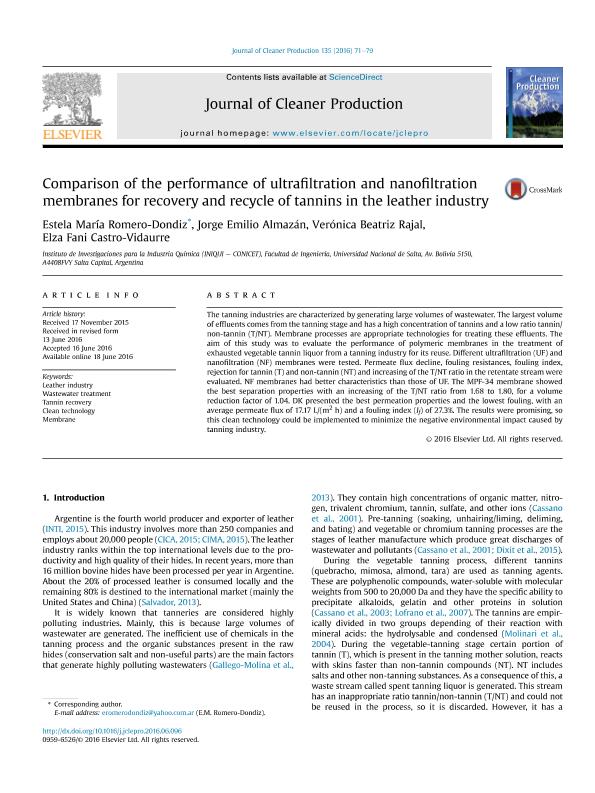Artículo
Comparison of the performance of ultrafiltration and nanofiltration membranes for recovery and recycle of tannins in the leather industry
Romero Dondiz, Estela María ; Almazán, Jorge Emilio
; Almazán, Jorge Emilio ; Rajal, Verónica Beatriz
; Rajal, Verónica Beatriz ; Castro Vidaurre, Elza Fani
; Castro Vidaurre, Elza Fani
 ; Almazán, Jorge Emilio
; Almazán, Jorge Emilio ; Rajal, Verónica Beatriz
; Rajal, Verónica Beatriz ; Castro Vidaurre, Elza Fani
; Castro Vidaurre, Elza Fani
Fecha de publicación:
11/2016
Editorial:
Elsevier
Revista:
Journal Of Cleaner Production
ISSN:
0959-6526
Idioma:
Inglés
Tipo de recurso:
Artículo publicado
Clasificación temática:
Resumen
The tanning industries are characterized by generating large volumes of wastewater. The largest volume of effluents comes from the tanning stage and has a high concentration of tannins and a low ratio tannin/non-tannin (T/NT). Membrane processes are appropriate technologies for treating these effluents. The aim of this study was to evaluate the performance of polymeric membranes in the treatment of exhausted vegetable tannin liquor from a tanning industry for its reuse. Different ultrafiltration (UF) and nanofiltration (NF) membranes were tested. Permeate flux decline, fouling resistances, fouling index, rejection for tannin (T) and non-tannin (NT) and increasing of the T/NT ratio in the retentate stream were evaluated. NF membranes had better characteristics than those of UF. The MPF-34 membrane showed the best separation properties with an increasing of the T/NT ratio from 1.68 to 1.80, for a volume reduction factor of 1.04. DK presented the best permeation properties and the lowest fouling, with an average permeate flux of 17.17 L/(m2 h) and a fouling index (If) of 27.3%. The results were promising, so this clean technology could be implemented to minimize the negative environmental impact caused by tanning industry.
Archivos asociados
Licencia
Identificadores
Colecciones
Articulos(INIQUI)
Articulos de INST.DE INVEST.PARA LA INDUSTRIA QUIMICA (I)
Articulos de INST.DE INVEST.PARA LA INDUSTRIA QUIMICA (I)
Citación
Romero Dondiz, Estela María; Almazán, Jorge Emilio; Rajal, Verónica Beatriz; Castro Vidaurre, Elza Fani; Comparison of the performance of ultrafiltration and nanofiltration membranes for recovery and recycle of tannins in the leather industry; Elsevier; Journal Of Cleaner Production; 135; 11-2016; 71-79
Compartir
Altmétricas



